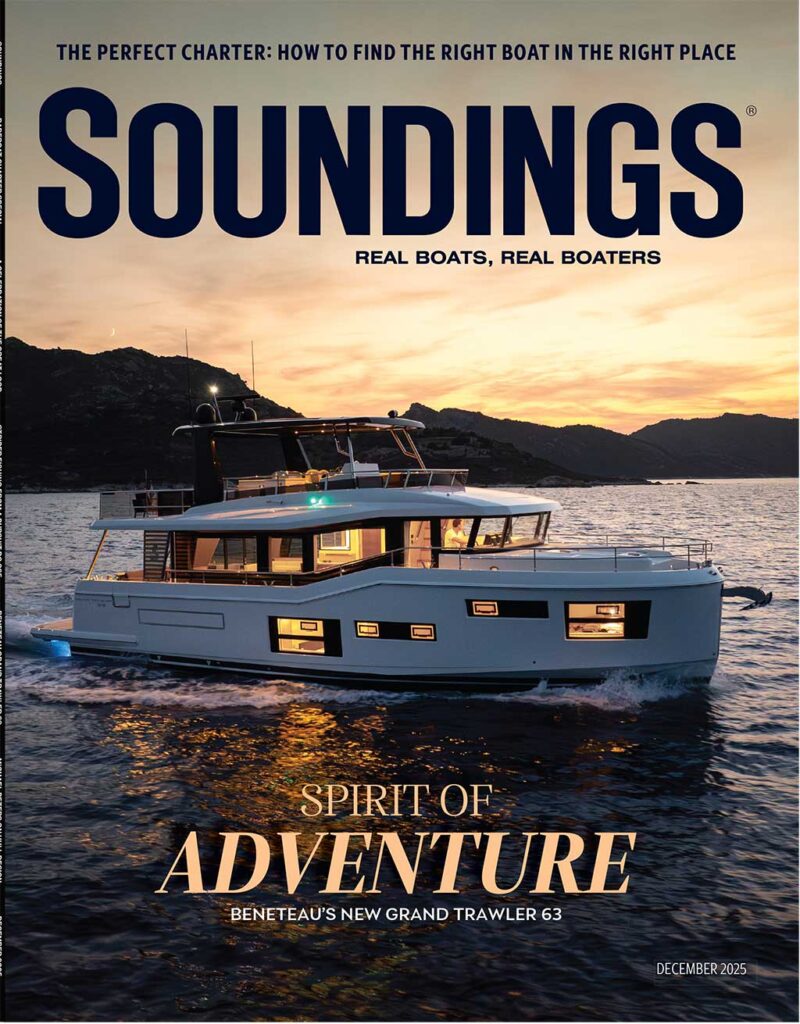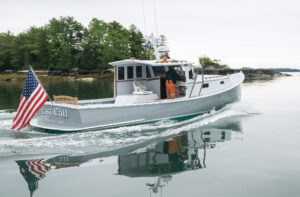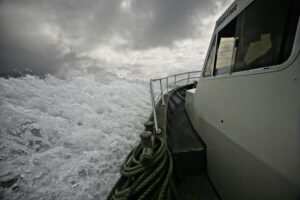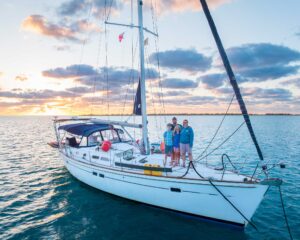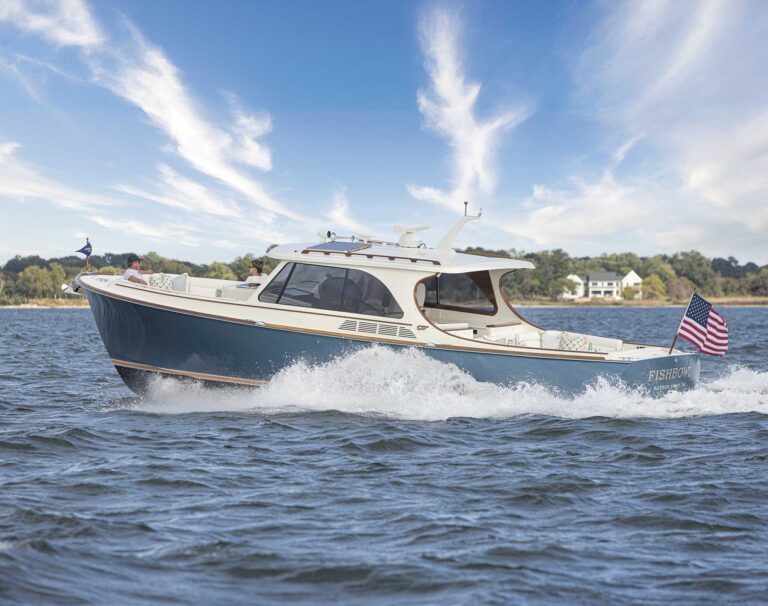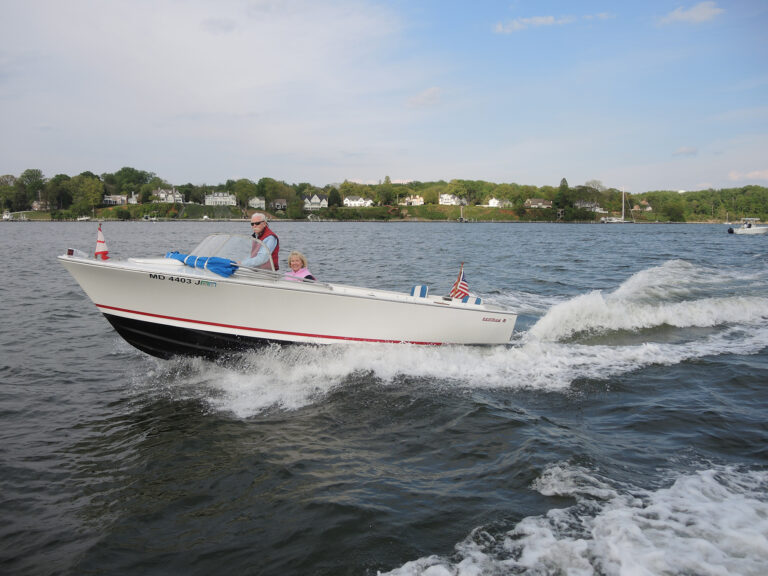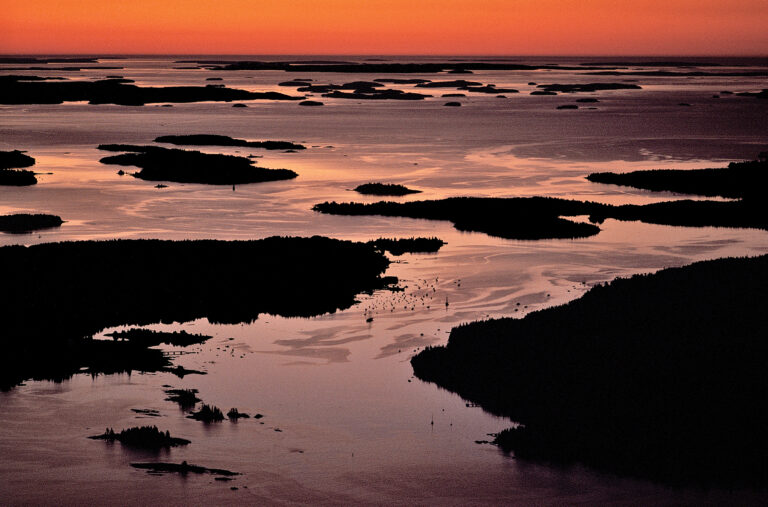 Max Campbell
Max CampbellNailing down a free spirit is a logistical nightmare, particularly if that spirit is across the ocean, hundreds of miles away from the nearest landmass. “Max Campbell is available this week,” my editor texts me. “Get him on the phone while you can.”
Campbell, is halfway across the world on a circumnavigation he began in early 2020. He set sail from his homeport of Falmouth, England, aboard a 1970 Sparkman & Stephens-designed Swan 37 he found languishing in a boatyard. Landfalls are common on his voyage, but so are weeks-long passages without cell service.
The 28-year-old has a tenuous relationship with terra firma, and yet he’s surprisingly easy to find. His Instagram bio places him in New Zealand, and a GPS tracker reveals Elixir, his lovingly restored monohull, is docked in Opua, a picturesque entry port for overseas boats arriving in the country. On TikTok alone, his videos receive anywhere from hundreds of thousands to over a million views.
 Max Campbell
Max CampbellWhen I get Campbell on the phone, he’s already been in New Zealand for two months. In that time, the accomplished sailor and content creator has written a few articles, posted some videos and purchased a 1999 Toyota Corolla for $2,000. “I drove it down to the South Island for a bit just to see it, because it’s such a beautiful country,” he says. Before moving onto Fiji in spring 2025, he plans to refit Elixir for the back half of his voyage. His circumnavigation is entirely self-funded, so to pay for the maintenance that’s necessary after 16,000 miles, he’ll spend his downtime delivering yachts and working odd jobs. Freelance writing assignments help pay the bills, as does sponsored content, which allowed him to acquire main sails essentially gratis.
Campbell isn’t a vapid influencer cavorting around the South Pacific with dad’s money. He’s the real deal, a bona fide sailor who once singlehanded a transatlantic passage in a 22-foot wooden sloop. His exploits are well-documented on Un-Tide, his multimedia platform, and YouTube, with a focus on sustainability and respect for others. Most of his videos are buoyed by strong production values and the charming personalities of his multicultural friends.
 Max Campbell
Max CampbellThat’s the other thing: Campbell doesn’t go it alone. Elixir has seen a revolving door of crewmates who join him for individual passages. These transient sailors bunk up in one of two cabins on board. Campbell hosted as many as 60 people since he started the voyage. Some crewmembers have done singlehanded passages of their own, while others arrive with very little offshore experience. For Campbell, a person’s skill set doesn’t matter as much as passion for the experience, and the ability to pull your weight when onboard. “When you’re sailing, a lot of the time you’re very removed from society, you know?” he says. “And a lot of people choose to do it alone, which is cool. But for me, I just think the experience is so much better shared with other people.”
Campbell and his crew have navigated through tropical storms, swam with bioluminescent plankton and visited remote island communities in the Pacific. But he’s also been thrown in a prison cell in Mexico and robbed at gunpoint in Venezuela. Through it all, he comes across as a genuine, literary soul, a person fueled by romance and what some might consider a touch of madness. Although the longer you speak with him, the more you realize that we might be even crazier for seeking the relative comfort of a conventional life.
After graduating in the top of his class from the University of Southampton with a degree in oceanography, Campbell felt stuck. A stable career awaited, but the sea had been calling for much longer. It didn’t help that at the age of 4, his stepfather presented him with a 10-foot-long coldmolded dinghy with a bright yellow main. Thereafter, Campbell could be found enthusiastically sailing his first boat through the rust-colored waters of Bristol Harbour. By the time his family moved to Falmouth, on the coast of Cornwall in southwest England, he was racing dinghies competitively. His biggest fear wasn’t landing the right job; it was the prospect of never leaving the safe—if restrictive—embrace of a shoreline and watching his passion slowly fade away.
 Max Campbell
Max CampbellThat explains how he found himself alone aboard the 22-foot sloop Flying Cloud on a stormy passage to Gran Canaria—one of Spain’s Canary Islands. What began as a gap-year adventure with his best mate, Harry Scott, to Brittany, France, had become a singlehanded Atlantic voyage through tempestuous seas off the coast of Africa. Campbell had spent the year prior restoring Flying Cloud, which he bought for £500. He left the UK with the equivalent of $3,000 in his pocket before his friend jumped ship in Lisbon. “Harry, my crew and best friend, succumbed to a girl with a van,” he wrote. “It was an emotional goodbye and, initially, I felt lonely and slightly dispirited at the thought that I no longer had my best friend around to share conversation and boost morale.”
Prior to leaving, Campbell hadn’t shared his backup plan of crossing the Atlantic with a single person. When he eventually called his parents from Spain to fill them in, his stepfather, Dave Cockwell, a boatbuilder by trade, didn’t dissuade him. Instead, he imparted some much-needed wisdom: “Make sure the boat is ready for it.” Together, Cockwell and Campbell created a series of drawings for bespoke self-steering gear: a vertical wind vane linked to a trim tab on the back of the rudder that would replace the bungee cord Campbell had Jerry-rigged to the tiller. A friend made a canvas sprayhood, and Campbell drilled two holes in the transom to increase drainage. “It wasn’t totally self-draining,” he writes, “but it was so much better than nothing.”
 Max Campbell
Max CampbellAfter a harrowing passage in the Canaries with following seas breaking over the stern and three reefs to the main to better combat the ferocious squalls, Campbell settled into a steady passage of 100 nautical miles a day by riding the northeasterly tradewinds toward the Caribbean. After about 10 days, he felt something invariably change inside of him.
“When you’re offshore sailing, your routine is nothing like on land. To me, it feels way more aligned with what human beings are meant to be doing,” he says. “You’re completely immersed in nature, and the things that typically cause stress in day-to-day life—money, work, relationships, whatever—they all cease to exist when you’re sailing for weeks on end. So, it brings about this simplicity, which is almost euphoric. That feeling is what got me hooked.”
To pass the time, he would drop a line and fish, or read books written by daring sailors whose wake he seemed destined to follow. When he was about 200 miles from Grenada, everything suddenly changed. While priming a kerosene stove, the can of denatured alcohol he was holding in an outstretched hand got too hot and made a popping sound. Describing it later as a guest on the On the Wind sailing podcast, Campbell told the host when he heard the noise, “I just knew then I was [screwed].” The can exploded, dousing his face and shirtless torso in hungry flames. Without a moment of thought, Campbell held onto a stanchion and flipped himself over the side to extinguish the flames. Charred pieces of skin fell off his arms, chest and torso and several big blisters had formed quickly on his face.”
Luckily, he had the foresight to stow a first aid kit on board and was familiar with treating injuries from his time working with the Royal National Lifeboat Institution. “I used dressings, creams, antibiotics and painkillers, making myself look more like an Arabian nomad than a sailor,” he writes. “After 18 days of heaven, I had to endure two final days of hell.”
Whether by instinct or adrenaline, holding onto the stanchion had saved his life. But there was no time to celebrate. He still needed to sail Flying Cloud the rest of the way to Grenada. During the day, the cheerful sun and salt spray were suddenly diametrically opposed to his survival as he fought to change the sails. At night, when he would try to sleep, he could feel the blisters rupture on his shoulders. When he finally caught sight of land in the distance, he was dehydrated and delirious. He never felt that he needed to radio for help, but also knew he couldn’t spend another night in his present condition.
Campbell made landfall in Prickly Bay on the southern side of Grenada. With the help of some sailors he met in Cape Verde, he dropped anchor and left Flying Cloud in a hurricane hole. He went straight to the hospital, where he was told he had suffered second-degree burns on over 14 percent of his body. He returned home a failure—or, at least, that’s what he told himself. Besides recovering from his injuries, he was dealing with the acute feelings of PTSD, depression and anxiety. Talking to people was suddenly difficult. He needed to avoid the sun anyway, but for months he became a shut-in.
Thankfully, that’s not where the story ends for Campbell, who is the latest recipient of the Young Voyager Award from the Cruising Club of America. “I felt like that was the most I’d ever grown in that year,” Campbell says. After slowly building up his courage, he bought a plane ticket back to Grenada, where he found Flying Cloud in poor condition after spending a year in the tropics. When he sailed home a month and a half later on his return passage, he felt “a little bit unstoppable.”
That feeling of renewed confidence led him back to Mylor Creek Boatyard, where his stepfather oversees yacht maintenance, a brokerage and a production facility building superyacht tenders and motoryachts. It’s also where Campbell first came across Flying Cloud, and where he would eventually find the Swan 37, Elixir.
The Elixir refit was extensive, requiring the help of countless friends who took turns sanding, filling, fairing and painting the entire hull. They also used a CNC machine to craft the handrails, vents, cleats and rebuild the rudder shaft.
“When I was rebuilding Elixir in the shed, I had this dream of being in the South Pacific on the boat and surfing and visiting all of these remote islands,” Campbell says. “And then one day, it was happening. It was really kind of a surreal moment.” He purposefully chose Elixir for her size and seaworthiness so he could bring not only more friends with him, but also his surfboards. The swells in paradise have been appropriately epic.
Almost every person who helped to restore Elixir in some way has come sailing with him on this circumnavigation. A handful have even gone on to purchase sailboats of their own. “The experience really ignited a passion in them, which I think is so cool,” he says.
As for Campbell, when he eventually sails back to Falmouth, he plans on buying an even bigger boat on which to take paying (and nonpaying) clients offshore sailing. On top of that, he likes the idea of continuing to grow the Un-Tide brand and “go to cold places” on his next boat.
For this adventurous sailor, there’s seemingly no end in sight to his travels. Says Campbell, “Ever since I did that first trip on Flying Cloud I was like, ‘This is what I’m going to be doing forever.’”
This article was originally published in the April 2024 issue.

